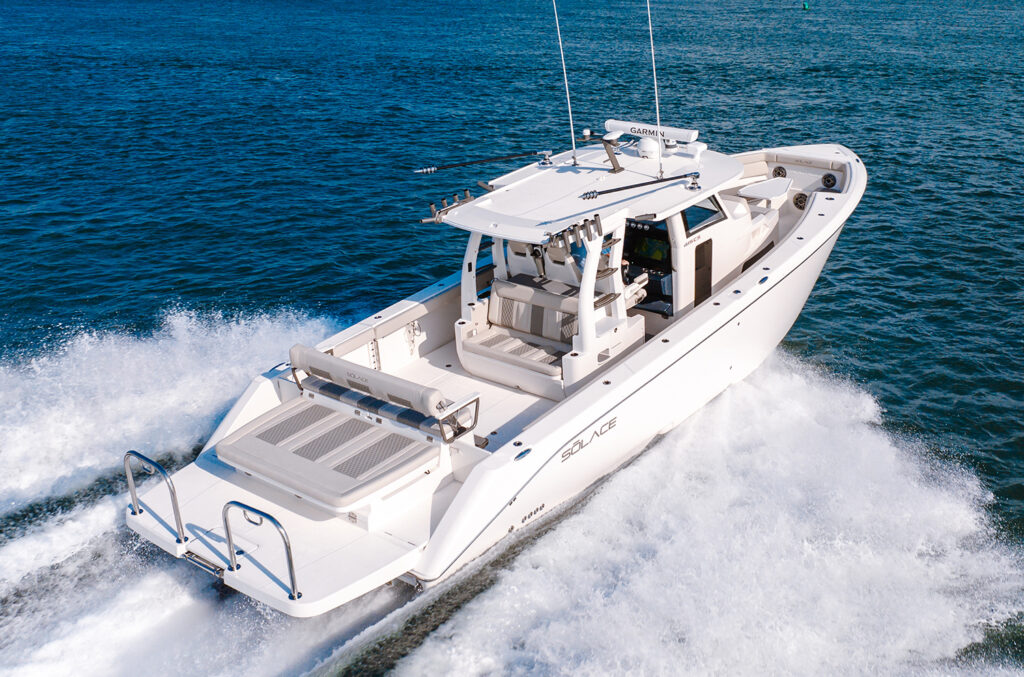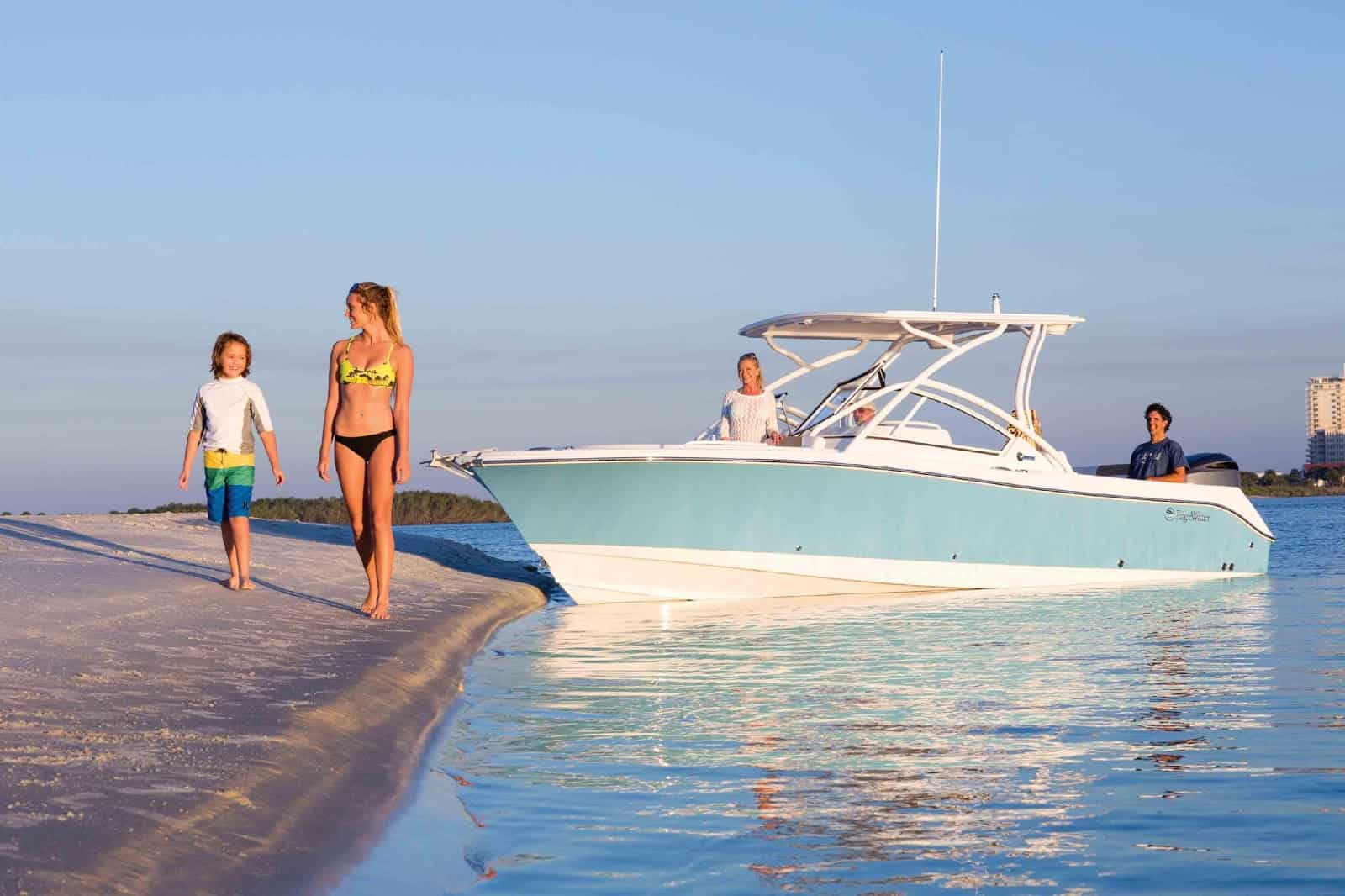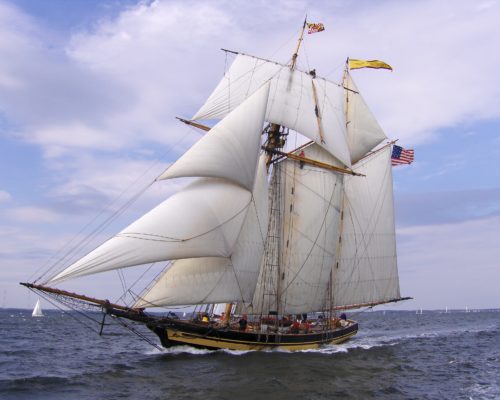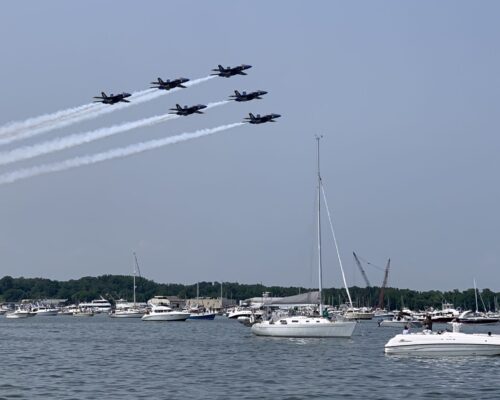Solace Boats has entered a deep partnership with Chesapeake, Va.-based Volvo Penta to produce the 415CS, a top-of-the-line, state-of-the-art, and forward-looking 41-foot center-console. The cabin is large enough to accommodate a couple for a long weekend or even more, while the bow deck, helm, and cockpit can serve a small crowd for socializing or serious fishing. We had an opportunity to spend some time on hull #1 during the Annapolis Powerboat Show and came away suitably impressed.
At a time when large outboard motors are (justifiably) all the rage, the engineering synergy between Solace and Volvo Penta integrating a sophisticated, double-stepped hull with twin 440-hp D6 diesel engines turning DPI (dual-propeller) outdrives makes a compelling case for efficiency, range, and seaworthiness. That synergy also hints at a future running carbon-neutral fuel and retrofitting a hybrid diesel-electric power system.
LOA: 41’
Beam: 12’3’’
Draft: 24’’
Weight: 25,000 lb (dry)
Transom Deadrise: 23 degrees
Bridge Clearance: 8’4’’/9’2’’
with radar
Fuel Capacity: 444 gal
Water Capacity: 40 gal (6 gal hot)
Waste Capacity: 18 gal
Persons Capacity: 16
Max power: 880 h
The Solace 415CS and its outboard-powered sister, the 41CS, are thoroughbreds from boatbuilding royalty, the Dougherty family. Solace Boats is the creation of Stephen Dougherty and his wife, Sarah. Many readers will recognize Stephen as the son of Bob Dougherty, who joined Boston Whaler in 1960, two years after its founding, and remained the person best known for the success of that brand for the next 30 years. Stephen joined his father there, starting on the production line, and working his way up until they both left in 1990 to found EdgeWater Boats and then Everglades Boats, along with the predecessor of Dougherty Manufacturing, a diversified company with expertise in engineering, tooling, mold-making, metal fabrication, composite manufacturing, paint, CNC machining, and concrete mold fabrication.
Solace Boats sprang from Dougherty Manufacturing, under Sarah and Stephen’s ownership and management. No surprise that, as the Solace website declares, “[W]e design everything. We also handle our own tooling process, where we build all of our own plugs and tooling, utilizing state-of-the-art 5-axis CNC mills.” The dedicated team of craftspeople they have assembled represents many decades of experience and innovation in a wide range of specialties.
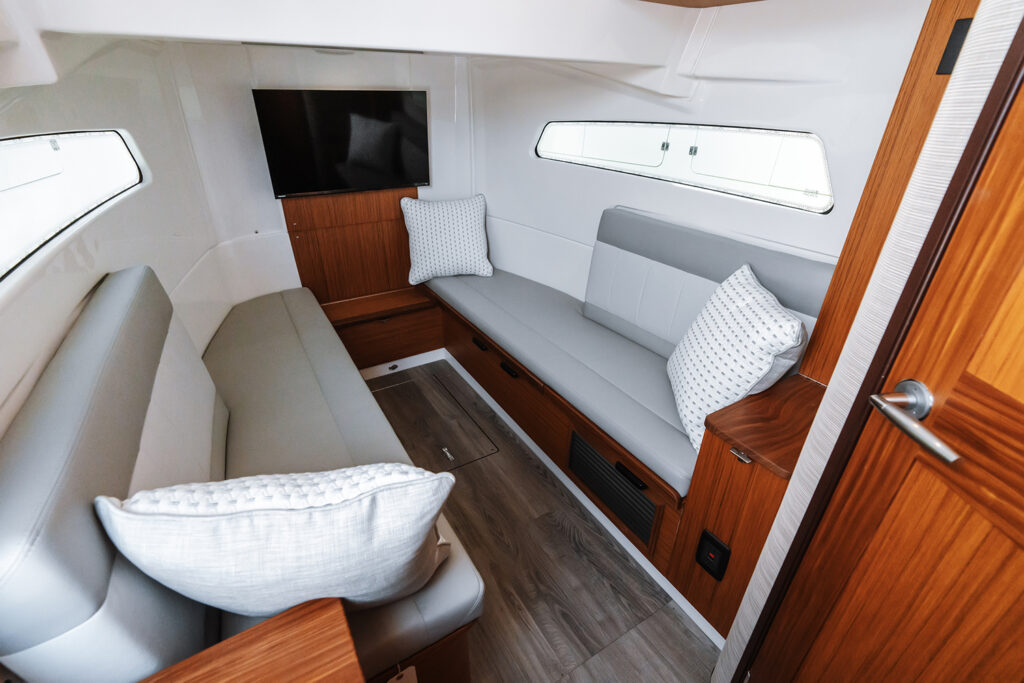
Like the three smaller Solace models, the 41s ride on deep-V (23 degrees at transom), double-stepped ventilated hulls with lifting strakes and wide reverse chines. The hull has a 12′ 3″ beam and it’s quite sharp (48 degrees at the bow entry). The steps introduce air to mix with water under the running bottom, reducing friction (making it “slippery”), while tracking chine rails on each side of the underbody hold the boat firmly in place in turns. They also help to hold the air bubbles where they do the most good at speed. The efficiency provided by those steps shows in a recent independent profile of the 415CS’s performance. There, the boat’s most economical cruising speed range turned out to be a distance-eating 21–37 knots (1.01–1.16 nmpg), producing a conservative range of 400–460 nautical miles and a spread of options for adjusting to sea conditions. Not bad for a 25,000-pound vessel. Quick trips from Annapolis to the mouth of the Choptank or Lynnhaven to the Chesapeake Light Tower, anyone?
Solace builds its boats with a process called Vacuum Infusion, laying up engineered, integrated fabrics of carbon fiber, Innegra (a high modulus polypropylene fiber), coring, and fiberglass, bonded with epoxy and vinylester resins. In particular, the Innegra amplifies the performance of the other composite fibers, especially by damping vibrations and increasing impact resistance. The lamination crew lays up each boat’s hull and stringer grid together and infuses them that way, allowing them to cure together in the mold. Then they apply methacrylate adhesive and place the liner precisely into the hull/grid, effectively welding them together into one very strong unit, with the deck “ring mold” then bonded to it.
Equipping the 415CS is equally meticulous. Examples include a bow deck with three-across seating in front of the console, benches that double as forward-facing lounges port and starboard (storage under and table between), and an anchor locker with windlass. An integrated hardtop covers the console and helm/mezzanine seats, with an electronically actuated, fully opening windshield (including wipers and washer), LED lighting throughout, large service access hatches with heavy duty SS gas strut stays, port side-boarding door with swing hinge and grab handles, and under-gunwale storage compartments with concealed trash cans and wraparound coaming pads.
An oversized, full-perimeter gutter drains rainwater and the little spray that comes aboard. Magnets embedded in the fiberglass hold down all removable (magnetized) cushions and stainless cups in cupholders. All aluminum is treated with PPG Coraflon anti-corrosion coating. A JL Audio stereo system with 17 speakers and three amplifiers produces plenty of sounds everywhere, with three control panels.
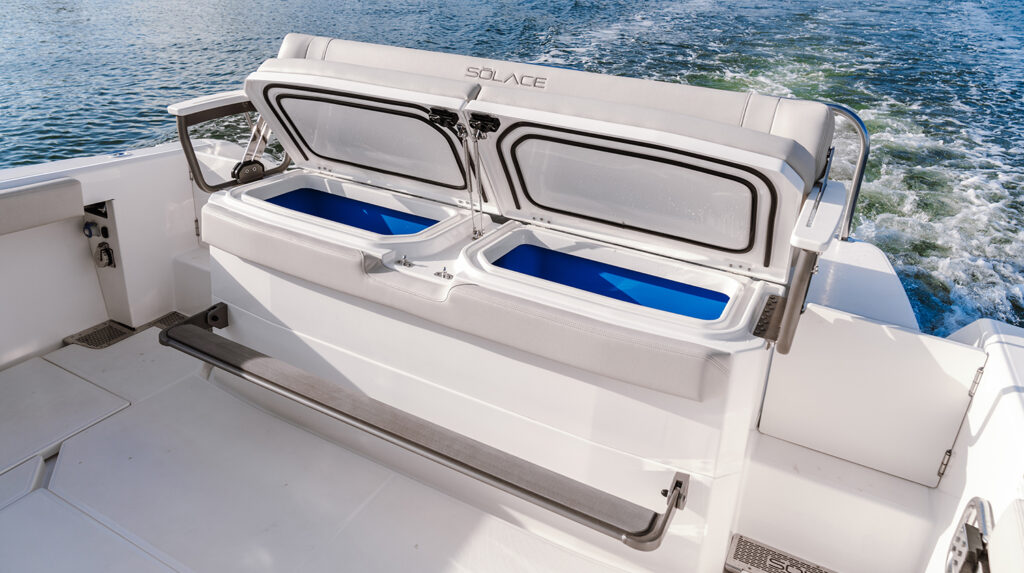
The cabin’s oversized door leads to a comfortable space with a twin settee that converts to a queen berth, an enclosed head with shower, 16,000 BTU air conditioning with reverse-cycle heat, wood cabinets with solid countertop, and a 32” LED television. At the helm are three chairs abreast with flip-up bolsters and armrests on shock mitigation mounts. An electrically actuated shock-absorbing pad adjusts vertically to optimize sightlines for the skipper. Above the center steering wheel is a broad Volvo Penta Glass Cockpit layout with twin Garmin 8622 flush-mount multi-function displays and the main control panel for the sound system, with seven 2” air-conditioning vents arrayed atop.
The Volvo Penta Glass Cockpit helm is completely integrated with the engines, outdrives, and boat systems through the company’s Electronic Vessel Control and Garmin Digital Switching. Also included are twin VHF radios, a Fantom 24” 4kW radar dome on the hardtop, a GSD 25 sounder module, and an Airmar 500-watt CHIRP tri-transducer with SideVu and ClearVu recessed in the hull. The center helm chair armrest holds a Garmin Remote Input Device to starboard and a joystick to port (more on that below). To drive all of this wizardry, the 415CS has a 3000-watt inverter with 100-amp charging, a 40-amp battery charger, an AGM battery bank, and a 7.1 KW MASE diesel genset with sound enclosure (8.6 kW optional) mounted in the capacious lazarette under the cockpit sole.
The aft side of the helm chairs’ base unit offers three mezzanine seats. The boat we were on is the prototype. The first production boat has a completely different rear facing seat and work station. Under the seat there’s a custom Frigid Rigid Cooler. The seat backrest folds down to access tackle storage. The starboard side has a drawer that stores a propane grill, and the port side has a freshwater sink.
At the transom is a large lounge that rises on electric rams to provide broad access to the two Volvo D6s for daily fluid checks and virtually any other maintenance needs. The lounge itself offers a movable back that converts it from forward- to aft-facing or a sunpad. Aft of it through walkways on either side lies a broad stern platform with hatches for access to the sterndrives and U-shaped safety stanchions for boarding, fighting fish, or handling them. A pair of sturdy doors close off the walkways when necessary.
Basic safety systems include four 2200 GPH bilge pumps placed in three zones, with high-water alarms and a Bilge Dry system. Three automatic fire extinguishers mount in two zones, secured in dedicated lockers. The aforementioned self-bailing cockpit drains through four 2” deck fittings on each side. Recessed toe kicks all around provide stability for leaning over the side. Stainless steel and aluminum grab rails come to hand almost magically when reached for. Dedicated hullside pockets make life jacket and throwable devices readily available.
The long list of fishing assets includes abundant tackle storage, 18 flush-mount rod holders in the gunwales and 11 across the transom, under-gunwale horizontal rod storage (three per side), under-gunwale locking rod lockers up to 6’6” (7 rods and one gaff or brush handle per side), a ten-rod rocket launcher on the hardtop, in-deck fishboxes, and multiple meticulously engineered livewells. For serious sight fishing, Solace offers an optional upper helm station with full controls. Access is easy thanks to broad steps built into each of the aft hardtop support arches.
As noted, the twin Volvo Penta D6 engines with DPI Aquamatic Sterndrives form a totally integrated package. The engines are in-line 6-cylinder, 5.5-liter, common-rail diesels with double overhead camshafts, turbo- and superchargers. They each turn individually steerable Aquamatic DPI sterndrives with twin counter-rotating propellers that harness the considerable torque of the D6s with great efficiency. Electronic Vessel Control provides extraordinarily smooth, silent gear shifting, a Dynamic Positioning System, and automatic Powertrim Assistant. In addition, it incorporates not only joystick maneuvering at low speed, but also Volvo Penta’s new, award-winning Joystick Driving technology at speed. We have to note, as a result of our sea trial, the uncanny feeling of piloting this 41′ x 12’3” vessel with the joystick not only at her 30-knot happy speed but also with precision at low idle speed around channel edges and oyster reefs. The new DPI outdrives include state-of-the-art anti-corrosion features. A Quick MC2 X7 supplies gyro stabilization.
Price with twin 440-hp Volvo D6 diesels turning DPT outdrives is $1,700,000. With quadruple 400-hp Mercury V-10 Verado or triple 450-hp Yamaha XTO Offshore outboards, it’s $1,600,000. For more information, visit solaceboats.com. The Chesapeake’s Solace Boats dealer is Bosun’s Marine in Grasonville, Md.
Editor at Large John Page Williams is a fishing guide, educator, author and naturalist, saving the Bay since 1973.

